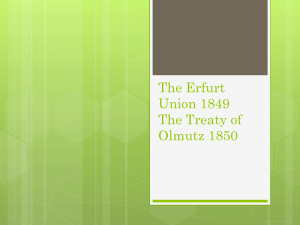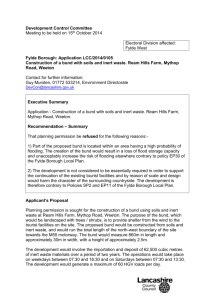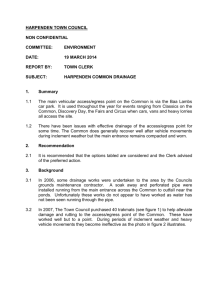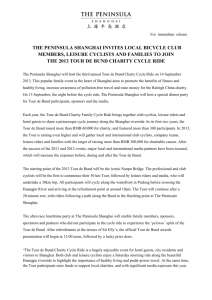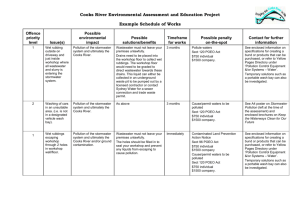Mehrauli Basin
advertisement
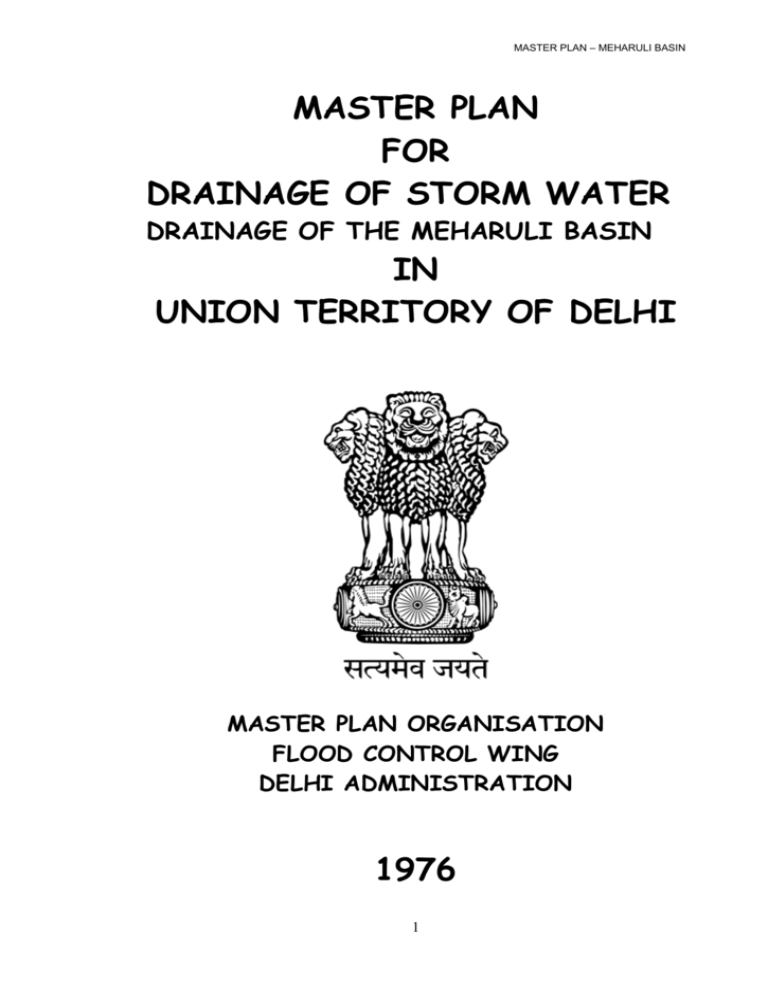
MASTER PLAN – MEHARULI BASIN MASTER PLAN FOR DRAINAGE OF STORM WATER DRAINAGE OF THE MEHARULI BASIN IN UNION TERRITORY OF DELHI MASTER PLAN ORGANISATION FLOOD CONTROL WING DELHI ADMINISTRATION 1976 1 MASTER PLAN – MEHARULI BASIN MASTER PLAN FOR MEHRAULI AREA S.NO INDEX DSCRIPTION PAGE NO. 1. TOPOGRAPHY 1.1 Hilly 1.2 Plain 1.3 Submersible Khadar area 4 4 4 5-6 2. RAINFALL STUDIES 2.1 General 2.2 Design Storm 2.3 Rainfall Dispersion factor 2.4 Design discharge 2.4.1 Hilly drains 2.4.2 Drains in rural plain areas 2.4.3 Drains in urban plan areas Frequency analysis Analysis-1a Rainfall frequency analysis Analysis-1b Analysis-1c 6 6 7-8 9 9 9 10 10 3. DRAINAGE OF MEHRAULI AREA 3.1 Drainage in Najafgarh Jheel 3.2 Drainage from North-West corner of Mehrauli area draining in to Najafgarh drain 3.3 Drainage from Northern slopes of Mehrauli discharging into Chirag Delhi drain 3.4 Drainage direct to Agra canal 3.5 Drainage above Ali super passage 3.6 Submersible plain between Agra canal & River Yamuna 4. DESIGN CRITERIA FOR MEHRAULI AREA DRAINS 4.1 Design discharge 4.1.1 Drains 4.1.2 Bunds 4.2 Rugosity Co-efficient 4.3 Design Velocity 4.4 Water Way at bridge/culverts 4.5 Free Board 4.6 Side slopes 2 11 12 13.14 15 16 16-18 18 18 19 20 21.22 22 22 22 23 23 23 23 23 24 MASTER PLAN – MEHARULI BASIN 5. BUNDS IN MEHRAULI AREA 5.1 Mahipalpur Bund 5.2 Rajokari Bund 5.3 Sultanpur Bund 5.4 Gadaipur Bund 5.5 Dera Bund 5.6 Asola Bund 5.7 Deoli Bund 5.8 Fatehpur Beri Bund 5.9 Mehrauli Bund-I 5.10 Mehrauli Bund-II 5.11 Jaunapur Bund 5.12 Aya Nagar Bund 5.13 Maandi Bund 24 24 25 25 25 26 26 26 27 27 27 27 27 28 6. GROUND WATER TABLE CONDITIONS IN MEHRAULI AREA 28-29 7. SUMMARY OF RECOMMENDATIONS Annexure-I Annexure-II 3 29-30 31 32 MASTER PLAN – MEHARULI BASIN MASTER PLAN FOR DRAINAGE OF MEHRAULI AREA 1. TOPOGRAPHY : The Union Territory of Delhi comprises mostly of flat plains with a hard rocky ridge extending roughly NE-SW. The Plains on either side of this ridge slope away from it. A major part of the rocky ridge on the south is situated in the Mehrauli Area. Topographically, the Mehrauli Area can be divided into three units:(i) (ii) (iii) Hard rocky area on the ridge (Hilly) Plain Submersible Khadar area. 1.1 Hilly: The southern boundary of the Union Territory of Delhi has a rocky ridge. In the South the quartizities are exposed near Chirag Delhi, Kalkaji, Tuglakabad and Mehrauli. The rocky outcrop around Chhattarpur area comprises of Alwar quartizities. An off shoot of this rocky ridge extending North-West, Passes by Mehrauli and turns North-East near Mahipalpur village. It rises 15 to 120 metres above the general ground surface. The hilly zone extends to several kilometers beyond Fatehpur Beri, Which is close to the Southern boundary of the State. On the East, it extends upto Badarpur and on the west it is limited upto Rajokri. The maximum elevation of the area is 320.3 metres above sea level located on the southern tip of the State. The general elevation in the northern part of the ridge is 256.96 to 267.63 metres above mean sea level. 1.2 Plains. The alluvial plain on the north-eastern side of the Mehrauli ridge extends upto the Agra Canal. The general slope of the area is towards the river Yamuna. It is bounded by the rocky area of Tuglakabad & Chirag Delhi on the West. The alluvial plain on the western side of the Mehrauli ridge extends upto Najafgarh Jheel on the West.The average ground level is 207.25 metres above mean sea level. 4 MASTER PLAN – MEHARULI BASIN There is a high level plain closed area of the quartzite ridge called Chhattarpur area lying to the South of Mehrauli. It has an area of about 78 Sq. Kilometers out of the total area of Mehrauli Block of 160 Sq. Km.(61.5 Sq. miles). This area has a slightly undulating topography with a very gentle depression at the centre and has an elevation of about 259.00 metres above the mean sea level. In the Chhattarpur area, the rock constitutes a basin which is filled up by the deposits of clay, Kankar, Sand and gravel. The thickness of alluvial cover in this basin varies from about 62 metres near Chhattarpur to about 116 metres near Chandan Hola. The intercalations of Kankar in the alluvial fill are lenticular in shape and restricted in extent. The Chhattarpur area and parts of Mehrauli area are occupied by a predominantly alluvium clay. 1.3 Submersible Khadar Area: This area is situated between the left bank of Agra Canal and the river Yamuna. This area gets submerged during monsoon in two ways (i) upland storm water from hilly catchments through all supper passage (ii) Flood Water from river Yamuna. It causes considerable damage to the crops in this area every year. The problems of flooding are described in details below. Drainage problem from all Super Passage: The storm water from 8225 acres of hilly area flows through the all Super Passage constructed across the Agra Canal & gets spread. In the low lying areas on the left bank of the Agra Canal upto river Yamuna. The general N.S.L. of the area varies from 197.5 to 198.2 m above M.S.L. There is no proper drainage arrangement for draining out this water. It causes damage to crops in an area of 1444 acres in Delhi and 1300 acres in Haryana. On an average one crop in 50% of area is lost every year. The natural drainage path has since been totally silted up . Flood problem from river Yamuna: The general N.S.L. of this area varies from 197.5m to 198.20m. whereas the H.F.L. of river Yamuna corresponding to 40, 000 cusecs flood in this area comes to 197.89m. As soon as the discharge in river Yamuna reaches to near about 40,000 cusecs, this area starts getting submerged. (When again the level of the river goes down this blocked upto water flows back to the river). The level and duration of discharges recorded at Okhla weir during 1975 floods are given below:5 MASTER PLAN – MEHARULI BASIN Statement showing Anticipated High Flood Levels of the Outfall point of All Drain. S.No. Discharges of River Yamuna at Okhla Wear Cusecs Cumecs in Lakhs 1. 3.00 8495 2. 2.50 7079 3. 2.00 5663 4. 1.50 4247 5. 1.00 2832 6. 0.80 2270 7. 0.60 1700 8. 0.40 to 1416 0.50 9. 0.30 to 1135 0.40 10. 0.20 to 850 0.30 Corresponding Yamuna Ft. Mtrs. July Aug. Sept. 957.77 656.820 655.820 654.620 653.12 652.72 651.32 650.340 200.485 199.230 199.925 199.505 199.070 198.945 198.520 198.255 -1 2 1 2 4 3 5 9 2 649.25 197.892 7 13 4 648.41 197.635 2 8 6 The above levels have been calculated as per plate No.3 Technical Committee Report on Shahdara drainage scheme and Okhla weir as per 1975 floods. The bed slope of river Yamuna D/S of Okhla weir has been taken as 1 in 4000. The Yamuna levels at outfall point of Jaitpur drain have been calculated after deducting 6.38th from the levels at D/S of Okhla weir. 2. Rainfall Studies for Mehrauli Area. 2.1 General: The Mehrauli area covers an area of about 160 Sq.K.m. of hilly tract mainly rural, in the southern most end of the U.T. of Delhi. According to the recommendation of Reddy Committee, 14 Self recording rain gauges have been installed throughout the Delhi Territory during 1972. Besides, there are existing rain gauge stations in the adjoining states viz. U.P. and Haryana. Out of the 14 self-recording rain gauges, one at Chandan Hola is situated at the centre of the Mehrauli area. Another station at Chirag Delhi is also quite close to it. Unfortunately, these rain gauges were installed only in the year 1972 and data for three years i.e. 1973,1974 and 1975 are available. It is not 6 MASTER PLAN – MEHARULI BASIN possible to carry out the storm frequency analysis on the basis of three years data. Therefore, these data could not be used for this purpose. However, for studying the area distribution factor of rainfall for different sizes of catchments these data were utilized. Typical storm isohyets were plotted and analyzed, utilizing the rainfall data both hourly and three day duration, of all these 14 self recording stations. For the design storm studies of one hour intensity, the long-term data available from Palam only has been used for reasons mentioned above. For the three day duration storm analysis, data from the ordinary rain gauge stations situated at Gawal Pahari Bund and New Bhatkal Bund (under Haryana Government) and the Palam rain gauge station under IMD were utilized. Particulars of these data are listed below:S.No. Name of rain gauge station 1. 2. 3. Gawal Pahari Bund New Bhatkal Bund Palam Type Authority in charge Data available Ordinary Haryana Govt. 10 years (1965-74) Ordinary -do- 10 years (1965-74) 35% 24 years 25% Self Indian recording Meteorological Department Theissen polygon weight age for the catchment area. 40% 2.2 Design Storm: Mehrauli area consists of partly hilly and partly plain tracts of agricultural lands, drained by natural water courses. The Reddy Committee, in their recommendations had proposed that the drainage systems in rural Delhi, should be so designed as to restrict flooding to a maximum period of three days, with a return period of 5 years. The 3 day maximum rainfall series of Palam, New Bhatkal Bund and Gawal Pahari Stations are available for a concurrent period of 10 years i.e. from 196574, which have been put to frequently analysis. The 3 day maximum rainfall corresponding to 5 years, 10 years, and 25 years frequency comes to 11.2”, 14.4” and 17.1” respectively (vide analysis-I). For comparative 7 MASTER PLAN – MEHARULI BASIN study, the point rainfall at Palam for which the data is available for longer period of 24 years, has also been statistically analysed which gives 3 day maximum rainfall of the order of 8.5” (analysis-II) for a return period of 5 years. Similar studies of design storm was carried out by the Reddy Committee in 1958 on the basis of Palam data and a figure of 8.2” as 3 day maximum rainfall for 5 years frequency was recommended. The storm rainfall studies as carried out on the basis of three rain gauge stations viz. Gawal Phari Bund, New Bhatkhal Bund and Palam which are most representative, appear more realistic and a figure of 11.2” for the Mehrauli area is recommended for adoption. The Mehrauli area consists of hilly tract with steep slopes, where small storage reservoirs have been provided for seepage irrigation and recharging the sub-soil water table. As per the norms fixed by the Minor Irrigation /Department of Ministry of Agriculture, the spill way design for all such storage works are normally based on storm rainfall of 10 years frequency. But in case there is any risk involved to the properties downstream, the spillway design may be used on rainfall frequency of 25 years return period. The maximum hourly rainfall data of Palam rain gauge station is available for a period of 9 years i.e. from 1966 to 1974. The same has been processed and subjected to statistical analysis (analysis-III). The design storm for different return periods have been worked out and tabulated below:Frequency Estimated rainfall based on Palam rain gauge station 3 days Max. Max. hourly rainfall rainfall (Analysis-II( (Analysis-III) 1 year 2 years 5 years 10 years 25 years 8.5” 10.65” 13.56 1.28” 1.72” 2.29” 2.73” 3.30 8 Estimated 3 days max. rainfall based on Gawal Pahari New Bhatkhal Bund and Palam rain gauge stations (Analysis-I) _ 11.2” 14.4” 17.1” MASTER PLAN – MEHARULI BASIN 2.3 Rainfall Dispersion Factor: The study of rainfall records of recent years i.e. 1973 to 1975 for the different R.G. stations spread over Delhi reveals that, the rainfall in Delhi is quite erratic and Palam rainfall cannot be taken as representative for the different areas of Delhi. Further, the rainfall at Palam represents only 25% of the Mehrauli area, according to the Thiessen polygon weighted values worked out. It is, therefore, necessary to adopt suitable area distribution factors for the various sub-catchments in Mehrauli area, while designing the drains. The area dispersion factors for point rainfall to be adopted for different sizes of catchments have already been discussed in chapter 3.8 of the outline of the Master Plan for drainage. The same should be adopted. 2.4 Design Discharge:The following criteria for the design of the drains and also the spillways of bund in Mehrauli basin are recommended: 2,4.1. Hilly drains (with intercepted flat reletention areas) Three day storm runoff of 5 years frequency is to be drained off in 3 days. The design storm for 3 days for Mehrauli area is 11.2” (5 years frequency).The runoff co-efficient to be adopted is 0.7. the area distribution factor for all sub-catchments of Mehrauli area (which are of medium size) is to be 0.9. The unit discharge for the design of these drains will therefore be 11.2 x 640 x 90 x 70 =64 cusecs per Sq. miles. 12 2x3 100 100 (i.e. 1/10 cusecs per acre). The bridges and culverts along the hilly drains should however be designed for double the design discharge of the drains. Linear waterways may be same as the drain bed width, but the foundation and vertical clearances should be safe for 100% extra discharge. Where any bridge or culvert in a hilly drain exists within thousand feet downstream of a bund spillway which intercepts the drain the above bridge or culvert should be designed either for the spillway capacity or for double the drain capacity, whichever is higher. 9 MASTER PLAN – MEHARULI BASIN 2.4.2 Bund Spillways: (a)New Bunds: For new bunds like Asola, Deoli, Aya Nagar and Mandi, where the basins are still having hilly characteristics the spillway and the outlets are to be designed for a 25 years frequency rainfall of 1 hour intensity, with area distribution factor 0.90 and runoff factor 0.70/ hour intensity of storm of 25 years frequency for Palam is 3.309”. the Unit discharge for such structures will therefore be 2 cusecs per acre (3.309 x 0.9 x 0.7= 2.08” say 2 inches). (b) Bunds on relatively flat catchment: For bunds where the catchment is considerably filled up and has developed into a flat terrain, three days storm runoff of 5 years frequency is to be drained off in three days. The runoff co-efficient and area distribution factors will be 0.7 and 0.9 respectively. The unit discharge of these spillways will therefore be 64 cusecs per sq. miles (vide calculation in para 2.4.1). 2.4.3.Drains in rural plain areas: For drains in the plain rural areas in the Mehrauli area, adopt a 5 year design storm of 11.2”, area distribution factor 0.9 and runoff coefficient 0.715. The unit discharge of such drains will therefore be 11.2 x 640 x 90 x 15 =13.5 say 14 cusecs per Sq. miles. 12 2x3 100 100 2.4.4. Drains in urban plain areas: Adopt ½ cusecs per acre as the unit discharge for drains in urban plain areas in this basin. 10 MASTER PLAN – MEHARULI BASIN Analysis 1 (a) FREQUENCY ANALYSIS FOR 3 DAYS MAXIMUM RAINFALL FOR DIFFERENT RETURN PERIODS. (Mehrauli Block- Gwal-Pahari, considered)(Details attached) Y = X = X2 = B = EY N EX N 0.1180 = = EXY - N.X.Y. EX2 – NX2 Bhatkal 1884.731 10 3.4373 10 = = = Palam Rain = 188.4731 = 0.34373 = 896.797-10x.3437x188.4731 2.095 - 10x 0.1180 = 896.797 – 648.000 0.915 272 = A and Y – B.X 188.4731 – 272x .34373 188.4731-93.48 =95 Line of best fity = = Return period T in year 95+272 Log 10 T A+B Log T Log 10T Estimate Rainfall 5 years 0.699 285.1mm=11.2” 10 years 1.00 367mm=14.4” 25 years 1.3979 435mm rainfall= 17.1” 11 gauges MASTER PLAN – MEHARULI BASIN MEHRAULI AREA RAINFALL FREQUENCY ANALYSIS Number of years of Road (N) = 10 (1965-74) Years 1972 1970 Peak R.F. in mm(Y) 413.809 203.892 1971 X=logT10 1 2 1.000 0.6990 413.809 161.900 1.000 0.490 211.901 3 3.33 0.5224 110.700 0.273 1969 204.385 4 2.50 0.3979 81.320 0.158 1967 176.639 5 2.00 0.3010 53.160 0.091 1966 158.221 6 1.66 0.2201 34.810 0.048 1965 149.930 7 1.428 0.1547 23.200 0.024 1968 132.929 8 1.250 0.0969 12.870 0.009 1974 111.025 9 1.110 0.0453 5.028 0.002 1973 94.994 10 1.000 0.000 0.000 0.000 29.278 3.4373 896.797 2.095 12 XY X2 T=N M 10.0 5.0 1884.731 M MASTER PLAN – MEHARULI BASIN Analysis 1(b) TABLE SHOWING RAINFALL INTENSITIES IN MEHRAULI AREA As per the weightages worked out by theisign polygene method. Year Station Weightage 1974 Palam Gawal Pahari (G.P.) New Bhatkal Bund (N.B.B.) 1973 1972 1971 1970 1969 Palam Gawal Pahari (G.P.) New Bhatkal Bund (N.B.B.) Palam Gawal Pahari (G.P.) New Bhatkal Bund (N.B.B.) Palam Gawal Pahari (G.P.) New Bhatkal Bund (N.B.B.) Palam Gawal Pahari (G.P.) New Bhatkal Bund (N.B.B.) Palam Weightage value (A x b) 25% 40% 3 days maximum rainfall in (b) m.m. 90.30 100.00 35% 138.43 48.450 25% 40% Total 122.20 90.00 111.025 30.550 36.00 35% 81.27 28.444 94.994 25% 40% Total 358.8 575.00 94.994 89.575 230.000 413.809 35% 269.24 94.234 25% 40% Total 197.80 265.00 413.809 49.450 106.000 35% 161.29 56.451 25% 40% Total 83.4 430.00 211.901 20.850 172.000 35% 108.71 38.048 25% Total 125.70 203.898 31.425 13 Weightage rain in the block E (axb) 22.575 40.000 111.025 211.901 230.898 MASTER PLAN – MEHARULI BASIN Gawal Pahari (G.P.) New Bhatkal Bund (N.B.B.) 1968 1967 1966 1965 40% 350.00 140.00 35% 97.03 32.960 Palam Gawal Pahari (G.P.) 25% 40% Total 124.30 125.73 204.385 31.075 50.292 New Bhatkal Bund (N.B.B.) 35% 147.32 51.562 25% 40% Total 246.20 134.37 132.929 61.550 53.748 35% 176.26 61.341 25% 40% Total 153.60 172.87 176.639 38.40 69.148 35% 144.78 50.673 25% 40% Total 122.2 191.77 158.221 30.550 76.708 35% 121.92 42.672 Total 149.930 Palam Gawal Pahari (G.P.) New Bhatkal Bund (N.B.B.) Palam Gawal Pahari (G.P.) New Bhatkal Bund (N.B.B.) Palam Gawal Pahari (G.P.) New Bhatkal Bund (N.B.B.) 14 204.389 132.929 176.639 158.221 149.930 MASTER PLAN – MEHARULI BASIN Analysis 1 (C) Theisin Polygon weight value for different stations. A1 A2 A3 A4 = = = = 15.25 2.58 20.36 23.40 Palam : 15.25 x 100 61.59 Gawal Pahari: 23.40 x 100 61.59 New Bhatkal Bund :20.36 x 100 61.59 15 = 25% = 25% = 40% = 40% = 35% = 100% 35% 100 MASTER PLAN – MEHARULI BASIN 3. Drainage of Mehrauli Area: Quite a few Nallas start from the ridges and flow in all directions. During monsoons these nallas carry the rainwater from the rocky terrain & the agricultural area. Major part of this is towards south into Gurgaon district of Haryana through a saddle in the terrain near village Maandi. Mainly there are six-basins of drainage systems of Mehrauli area (Shown in Drawing No.1) These are:Sub-Basin-1: Drainage into Najafgarh Jheel. Sub-basin-2: Drainage from North West corner draining into Najafgarh drain. Sub-basin-3: Drainage from the Northern slope discharging into Chirag Delhi drain. Sub-basin-4: Drainage direct to Agra Canal. Sub-basin-5: Drainage above Ali Supper passage. Sub-basin-6.: Submersible plain between Agra Canal and Yamuna. 3.1 Sub-Basin-1: Drainage into Najafgarh Jheel: As seen from the plain (Drawing No.M-1) storm water flows from catchments 1 to 9 from Mehrauli ridge to South of Mehrauli basin via natural deep nallas. These nallas are subject to degrees of floods during monsoon, depending upon the intensity of rainfall. The uncontrolled water flows, on account of steep slope (average gradient 1 in 50 to 1 in 300), with high velocity and the soil erosion takes place, resulting in further undulation in the existing topography of the area. As soon as the rainfall occurs, most of the runoff drain out through the nallas, with high velocities. To check the erosion of land and recharging the underground water table, thirteen bunds namely Mehrauli No.1 & 2, Sultanpur, Gadaipur, Aya Nagar, Jonapur, Fatehpur Beri, Dera, Mandi, Asola, Deoli & Mahipalpur have been constructed across the natural nallas. These bunds serve as Flood barriers and also improve the condition in two ways. Firstly the raise the water table on the upstream side of it and secondly soil particulars which come with water, get deposited and facilities soil conservation. As soon as the water level on the U/S side of the bund reaches the F.S.L., the excess water drains off slowly through their spillways & outlets. The discharge through the outlets are fractions of the total water collected in the deep Nallahs, thereby helping in raising the sub-soil 16 MASTER PLAN – MEHARULI BASIN water table. After flowing through a number of bunds such as Mehrauli No.1, No.2, Sultanpur, Gadaipur, Fatehpur Beri, Mandi, Asola, Dera and Aya Nagar the runoff from this basin goes to Haryana Territory. There is hardly any drainage congestion in this zone. This water reaches to Kosta Nallahs in Haryana and then to Ghatta or Badsahpur Nallas and ultimately spreads into Najafgarh Jheel. From the Najafgarh Jheel this water flows into N.G. Drain and ultimately drains out into river Yamuna near Wazirabad barrage. Total catchments of Mehrauli area draining to Jheel comes to 23000 acres. A description of these bunds in Mehrauli are given in para 5. The spillways and outlets provided in these bunds were based on some arbitrary as submission recommended by the Reddy Committee. Such as submission presumed that, there will be some flood routing the flood storage in these bunds resulting in moderation of the flood discharge over the spillways. In actual practice, however, it has been observed that on several bunds particularly Asola Dera, Mandi etc. the effect of any flood moderation in the basins upstream of these bunds are negligible. As a result, particularly 70 to 80% of the precipitation in their catchments directly run over the spillways as runoff. The catchments for these bunds being relatively small, the time of concentration is less. The initial rainfall in these catchments also created as saturated conditions in the sub-soil, before the heavier storms appear. Thus a number of observations in the recent years have proved that the existing capacity of the spillways and the outlets in a number of bunds in Mehrauli, are inadequate. Since a certain onrush of heavy runoff over an inadequate spillway causes serious danger, not only to the existing outlet structure but also to the bridges and buildings down below along the Nallas course downstream, these are potential sources of drainage problems. If the spillway suddenly collapses the discharge intensity may increase 2 to 3 times, than the carrying capacity of the drain downstream, on account of the additional flow of the stored water from bund. A uniform norm for calculating the required outflow capacity of different bunds, cannot be recommended. Some of the bunds have already out-lived their initial purpose. The catchment behind these bunds are already silted up and have developed into plain alluvial tracts which can bear a certain amount of rainfall storage and does not allow the run is because the ground contours have become flatter above these bunds. 17 MASTER PLAN – MEHARULI BASIN On the other hand, bunds recently built say during the last 15 to 20 years are still having very steep gradients in their catchment. The inflow from these catchments naturally will arrive at the spillways, in a much faster speed, without getting time to absorb or spread out. In this category also, some of the bunds are having large pond area with absorbing capacity, while the others are not having the same. From all these considerations, the existing spillway capacities of the different bunds were examined and necessary recommendations for their remodellings are proposed in annexure-1. None of these spillways should be provided with gates, as any error in the gate operation may create serious conditions downstream. In addition to these open spillways, provision of gated under success at lower levels must be made for emptying the reservoirs, if necessary, at any time. The spillway structures must be constructed with complete energy dissipation arrangements downstream, according to the standard practices of hydraulic structures. The abutments and wing walls should have proper embankments into the earthen embankments and must be properly designed against maximum possible scour. 3.2 Sub-basin-2:- Drainage from North-West corner of Mehrauli area draining into Najafgarh Drain. The runoff of the Mehrauli ridge towards its North-West corner (vide catchment 15 in drawing No.M-1) drains along the slope towards the Mahipalpur bund and ultimately goes into the Najafgarh drain, through Bijwason and adjacent areas. A new bund is also being proposed in this zone by the flood Control Wing, near the village Rajokari. There is hardly any drainage problem in this sub-basin. 3.3. Sub-basin-3 Drainage from Northern slopes of Mehrauli discharging into Chirag Delhi Drain. Runoff from the Northern slopes of the Mehrauli ridge drain out across a number of culverts, under the Mehrauli-Badarpur road, and ultimately discharges into the Chirag Delhi Nallah. Although the Mehrauli-Badarpur road for the outer boundary of the urbanized limits of Delhi, a few important developments have recently taken place on the rural side of this road. Amongst them a large area covering a military camp site and a resettlement project of DDA near Khanpur, are important. 18 MASTER PLAN – MEHARULI BASIN The runoff from Deoli bund and its adjacent areas directly reaches these installations along the steep gradients of the hilly drains and get stagnated at the road crossing on account of inadequate culvert provision. The bridge across this road, for passing Deoli Bund discharge into Chirag Delhi drain, is at present practically silted up. The heavy onrush of storm water from the hilly slopes get stagnated in this area to a depth of 3 to 4 feet and partly spill over the Mehrauli-Badarpur road and joins Chirag Delhi Nallah over the fields. Similar problems of lesser magnitude are also existing at the crossing of a number of other similar drains at different points of the Mehrauli Badarpur road. Since the problem of drainage of the runoff from bund is critical and creates serious drainage congestion across the Mehrauli-Badarpur road a regular drain is proposed from Deoli bund upto this bridge. (L-section is enclosed as drawing No.M-1.) the road level in this area also needs slight raising. The waterway of the existing culvert across this road at RD.600 is completely silted up and there is no proper water way, which needs immediate desilting under this culvert. The nallas bed at the bridge should be same indicated in the L-section above. The culverts at the crossing of the other minor nallas along the Mehrauli-Badarpur road are also silted up and need immediate desilting to the levels as shown in the L-section. 3.4 Sub-basin-4. :-Drainage direct to Agra Canal. A catchment of 2320 areas (catchment No.16) around Tuglakabad Fort, is sloping towards the railway line on the East. The runoff of this catchment is having outlets under the railway line and Mathura road and ultimately collects in a low lying area near village Madanpur Khadar. The hilly catchment of this basin is within the urban limits of DDA Master Plan which is being developed as an industrial complex. As a result, the ultimate runoff from this sub-basin is expected to be considerably increased after full development of the area. A part of this catchment in around Tuglakabad Fort will however remain improved as historical relic. The only natural outlet for drainage of this sub-basin is into the Agra canal, through a very inadequate inlet across the Molar bund on right bank of Agra canal. The drain is considerably chocked due to sand washings. On account of the inadequate water way of the above inlet and silting the drain, the runoff of the hilly catchment behind, causing serious drainage congestion in the Madanpur Khadar area which is being developed by DDA, as Ghosi Colony and often over flows the national Highway, 19 MASTER PLAN – MEHARULI BASIN disrupting the traffic. Considerable damage to the cultivated lands during the kharif season also caused every year. It is essential to provide a regular channel section, to carry the runoff from this hilly catchment, directly into the Agra Canal, without allowing it to spread over the low lying area near village Madanpur Khadar. An L-section of the proposed drainage channel across the Mathura Road, starting from the Railway line upto the Molar Bund is enclosed as Drawing No.M-1V. the existing structure at Molar Bund is proposed to be remodeled to a span of 6m. width with suitable outfall structure into the Agra canal. 3.5 Sub-Basin.No.5 Drainage above Ali Super Passage. The slopes of the Mehrauli ridge on its Eastern side, a considerable part of which is in Haryana Territory, drains through Ali Super Passage across the Agra Canal, after crossing the Railway line and National Highway and ultimately discharges into the river Yamuna near DelhiHaryana Boarder. A part of the runoff from the catchment No.18 gets partially moderated at a depression called Suraj Kund, in Haryana Territory. The runoff from the catchment No.17 however is having problem of proper drainage near Tuglakabad Fort. The natural course for this runoff was in ancient times, partly obstructed for the purpose of water supply to the Tuglakabad Fort. This obstruction as also the inadequate in the section of the natural drainage channel is causing serious water logging to certain Government installation and offices situated by the side of Mehrauli Badarpur Road. In order to give a relief to this problem a regular drain is proposed starting from Hamdard Institute of Medical Sciences upto Ali Super Passage. The L-section of this drain is enclosed as Drawing No.M-12. Another drain for carrying the runoff from catchment No.18 beyond Mathura Road, upto Ali Super Passage, is indicated in Drawing No.M-1. It may be mentioned that the tail end of both the above drains are through the campus of Badarpur Thermal Power Station. Improvements to their drain suggested are considered absolutely necessary, as otherwise the natural drainage from the upper reaches may, some times spill over and spread within the campus of B.T.P.P. 20 MASTER PLAN – MEHARULI BASIN Total discharge at Ali Super Passage as received from Catchment No.18 and 17 refer catchment area plan at appendix M-1 will be as calculated below: 1. Discharge from catchment No.18 outside U.T. boundary = 1100 cusecs received after moderation at Suraj Kund and Peacock Lake (Vide Haryana Governments letter No.400/6/3-W dated 4th February, 1976 Extract from which is enclosed as annexure-2. 2. Discharge from catchment No.17 and 18 (refer catchment plan at Drawing No.M-1) on the South of Mehrauli, Badarpur road (Hilly catchment Mehrauli area) Total Catchment = 2924 acres. Discharge (1) of 64 cusecs/Sq.mile 292.4 cusecs. 3. Discharge from catchment of Badarpur Thermal Power Plant and catchment No.17 on the North of Mehrauli Badarpur- road (within unban able limits) Total Catchment = 1541 Acres. Discharge (c) @ ½ Cusecs/ acres. = 770.50 Cusecs. = 2164 Cusecs. Existing capacity of the Ali Super Passage in 2500 cusecs, therefore, it is adequate to carry the discharge from its catchment areas and does not require remodeling of the super passage. 3.6 Sub-basin No.6: Submergible plain between Agra canal & river Yamuna. The water from catchment No.17 & 18 after flowing through the Ali Super Passage gets spread up in low lying area between Agra Canal and river Yamuna which submergible plain. The discharge from the upper catchment comes to about 2500 cusecs. The drainage congestion in this area is caused by the storm water passing through the Ali Super Passage constructed across the Agra canal and thereafter through a natural drainage Course. This natural drain passes through a pipe culvert across Ismailpur- Basantpur Road and the storm water used to find its way to the river Yamuna in Haryana Territory. This culvert has two rows of 14 pipes of about 0.6m. Diameter and this has even completely chocked with profuse growth of hyacinth. Beyond this culvert, the bed of the drain has been brought under cultivation. With the result the natural drainage has been blocked and the storm water spreads out in a wide area of Delhi and Haryana causing damage to the crops in the villages Madanpur Khadar, Ali 21 MASTER PLAN – MEHARULI BASIN Jaitpur, Hari Nagar, Mithepur, Molar Bund etc. in the U.T. of Delhi and Aghianpur, Ismailpur and Basantpur in Haryana. The problem of drainage congestion aggravates when the river during monsoon overflows its banks and floods the area. The plan of the area is enclosed as Drawing No.M-7. On the left bank of the Agra canal the Badarpur Thermal Power authorities have constructed a bund for disposal of Ash coming from Thermal Power Plant. The General N.S.L. of this low lying area varies from 197m. to 198m. Whereas the spill of the Ash Bund has been kept as 200.00m. with the result water remains stored in the area marked for disposal of Ash. This helps in charging of sub-soil water table of the area which is getting higher every year. Moreover, this bund has been constructed across a natural drainage depression through which the storm water of this area used to find its own way to the river Yamuna. The B.T.P.P. authorities therefore, constructed a small drain along the toe of the Ash bund and another outfall drain of a capacity of about 100 cusecs from near village Jaitpur. This drain is made entirely within the boundary of the U.T. and its outfall point is at right angle to the flow of the river. But the capacity of these drains are not at all adequate and the drainage problem in even now continuing. During the 1975 monsoon, it was observed that the toe drain had been completely silted up owing to heavy rain cuts in the Ash Bund. For providing relief to the area a drain with proper banks has been proposed from Ali Super Passage which will outfall into river Yamuna in Haryana Territory just near to Delhi- Haryana boundary this been suggested for better hydraulic conditions. The L- section of the drain is enclosed as Drawing No.8. Increasing the section of the toe drain has also been suggested which will be away from the toe of the Ash Bund so that there is no chance of silting. The L-section of the drain is enclosed as Drawing No.9.10. This drain will provide relief to an area of 1444 acres in Delhi Territory and 1300 acres in Haryana. 4.0 DESIGN CRITERIA FOR MEHRAULI AREA DRAINS. 4.1 Design discharge 4.1.1. Drains. Design discharge for hilly drains has been calculated on the basis of 64 cusec/sq.mile (vide 2.4.1.). 22 MASTER PLAN – MEHARULI BASIN Design discharge from urban catchment has been calculated on the basis of ½ cusecs/acre. 4.1.2.Bunds Design discharge of 2 cusecs/acres has been considered for calculating the spillway and the outlet capacity of bunds on hilly catchments such as Asola, Deoli, Aya Nagar and Mandi but the spillway and outlet capacity of bunds, which have got a relatively flat catchment, has been calculated considering design discharge of 64 cusecs/sq. mile. 4.2 Rugosity co-efficient. Drains have been designed using manning’s formula value of rugosity co-efficient N. in the formula has been adopted as given below: Type of sections Value of N. Unlined sections 0.025 Dry Stone pitched sections 0.018 to 0.020 Sections lined in cement sections 0.015 to 0.18 4.3 Design Velocity. Drains have been designed with the following limits of velocity. Type of Drain Max. Permissible velocity. Unlined sections 1.2m/ Sec. Stone Pitched 2m/ Sec. Brick lined or stone lined 2.5m/ Sec. Concrete lined 3m/sec. 4.4 Waterway at bridge/culverts: Waterway at bridge/culverts has to be designed for ultimate discharge with a 15cm. afflux variation from the above upto 25cm can be allowed to retain the existing sections of the structures wherever necessary. Foundation of the bridges and vertical clearance should be designed to be safe for at least 25% extra over the design discharge of the drain. Whenever, existing structures appears unsafe additional protection measures to be provided. 4.5 Free Board: Free boards to the drains has been provided as given below:Discharge Free Board 3 Upto 150 M /Sec. 300 to 500 mm Above 150M3/Sec. 500 to 1000 mm 23 MASTER PLAN – MEHARULI BASIN 4.6 Side (a) (b) (c) Slopes: For drains in cutting. 1:1 For drains in filling and embankments 1.5:1 Dry pitching (Brick & stone) 1:1 4. BUNDS IN MEHRAULI AREA:In the Mehrauli basin, to reduce the damages due to soil erosion and also to store rain water for recharging the sub-soil water table, earthen bunds have been constructed across different hilly nallas. Water is allowed to stand on the upstream side of the bunds during monsoon and is released through the outlets provided in the bunds, just before the rabi season. Some of these bunds are very old and may be of the Mugal period. The over flow arrangements of these bunds are having effect on the discharging capacity of the Nallas d/s of the bunds. They are though useful for flood moderation, but sometimes create concentrated flow on the drains downstream on account of sudden damage to the bunds or spillways. A Plan showing the location of bunds with their catchment area and direction of flow is enclosed as Appendix. During the past few years, existing bunds of Mahipalpur, Rajokri, Sultanpur, Gadaipur, Dera, Asola, Deoli, Fatehpur Beri, Mehrauli No.1 & 2 have been reconditioned and new bunds have been constructed at Jaunapur, Aya Nagar and Mandi. A number of these bunds are having inadequate outflow arrangements. Some are having only sluices and no open spillway. Some are having spillways but with considerably low discharging capacity. As a result, number of damages to spillways, sluices or the bunds themselves occurred in the past. Cases of bunds being over topped are also not rare. A statement is therefore enclosed (annexure-I), showing the required modifications to the existing spillways and outlets of the different bunds. These are proposed on the basis of the criteria discussed in para 4. The details of the different bunds are discussed briefly here under, indicating their existing particulars. 5.1 Mahipalpur Bund:Mahipalpur Pur Bund which was about 4600 m long out of which 1918 m has since gone into disuse due to diversion of Palam Gurgaon Road, owing to general development of the area and coming up of the factories etc. Part of the area being bund is built up. At present 2682m. length of bund 24 MASTER PLAN – MEHARULI BASIN is in use with 4.9m. top width and top level as 235.36m. This bund impounds the water from 1920 acres on its U/S. This bund has also provided with a spillway of size 18m. length, crest level 234.400 with 5 pipes of 0.90m. dia. This bund has also been provided with one outlet. Mostly area on U/S side of the bund has been leveled and is under cultivation. The underground water table has also gone up considerably. The surplus water from this bund through the spillway used to flow in to Najafgarh basin after crossing Palam Gurgaon road through the natural drains. The spillway of the bund needs remodeling. 5.2 Rajokari Bund (Old). The Rajokri Bund was about 1980m. long and an area of about 50 acres and has also gone into disuse, as the area on its upstream side has been leveled and is under agricultural use. The water table has also gone up considerably. 5.3 Sultanpur Bund. The bund is about 1800m. long. This bund crosses the main Mehrauli Gurgaon road. The top level of the bund is 265.40m. with 3m. top width and 2:1 side slopes. The catchment area on u/s side of the bund is 1574 acres. The maximum height of the bund is 3.87m. There is no spillway. Only two outlets have been provided in the bund with hand operating gate arrangements. The surplus water flowing through the outlets collects on u/s of Gadaipur Bund. This bund also caters the water through the spillways/ outlets of Mehrauli Bund No.1 & 2. 5.4 Gadaipur Bund:This bund is about 2804m. long and seems to be the oldest bund in the area. This bund joints the Mehrauli- Fatehpur Beri Road with Mehrauli Jaunapur road. The height of this bund varies from 1.00m. to 6m. The top level of bund is 257.550m. with 6.00m. top width and 2.:1 side slopes. The catchment area of the bund is 4608 acres. One spillway of 15.00m. length and its crest level at 256.050m. has been provided in the bund. In addition to this one outlet of 2.75m. size and its crest level at 253.165m. has also been provided for draining out the surplus water, which flows through the natural drains and collects on U/S of Fatehpur Beri Bund. The area on U/S side of the bund has been leveled and is under cultivation. The sub-soil water table has also gone up considerably. This bund caters the surplus water through the spillway/outlets of Mehrauli bund No.1 & 2 and Sultanpur Bund. The spillway of this bund needs remodeling. 25 MASTER PLAN – MEHARULI BASIN 5.5 Dera Bund:This bund is about 100m. long. The catchment area of the bund is 2560m. acres. The top level of the bund is at R.L. 263.790m. with 4m. top width and 2.5:1 side slope on U/S 2:1 on D/S side. This bund has been provided with one spillway of size 1.5m. and its crest level at R.L. 261.280m. One outlet has also been provided at R.L. 259.00m. with 0.90m. dia pipe for draining out the surplus water from its upstream side. The surplus water drained through spillway and outlet, flows into natural nallas and collects on U/S of Fateh Pur Beri Bund. Most of the area on its U/S side has been leveled. The ground water table has also gone up considerably. The spillway of this bund needs remodeling. 5.6 Asola Bund. This bund is about 950m. long and impounds the water of nallas draining the rocky ridge having a catchment area of 2260 acres. The top level of the bund is at R.L. 261.500m with 4.00m. top width 3:1 side slopes on U/S 2.5:1 side slope on D/S side. The spillway in the bund, was damaged during the floods of 1975 which is being redesigned. A section of the original bund in the nallas portion has been breaching year after year, when finally a retiring bund a spillway section was provided in 1965. The bund was extended for a length of 210m. to close another nallas in 197172 so that more area can be reclaimed on U/S of the bund. The spillway on this extension was damaged during the floods of 1975 as an unprecedented rainfall of 32 years frequency occurred and a very high discharge passed through the spillway. The surplus water drained through this spillway after flowing through the natural drains collects on D/S of Fatehpur Beri Bund. No outlet has been provided in this bund. The water table in this area has also gone up considerably. 5.7 Deoli Bund This bund is 2489 metre long and is constructed across three hilly nallas this impounds the water of about 2560 acres of catchment of these nallas. Top of the bund is at R.L. 239.25 metre and top width is 4.5 meter. Side slopes are 2:1 both U/S and D/S. Maximum height of bund is 11.6 meter. Bund is provided with a spillway of crest 30.48 metre at R.L.236.700 metre. It is also provided with a pipe outlet 1.2 m. diameter. The bottom of the pipe outlet 1.2m. dia metre. The bottom of the pipe outlet has been kept at R.L. 235.300m. The spillway of this bund needs remodeling. 26 MASTER PLAN – MEHARULI BASIN 5.8 Fatehpur Beri Bund This bund is 240 metre long & top of bund is at R.L. 253.90m. and top width is 3.65 metre side slopes are 2:1 both on the U/S side and D/S sides. Maximum height of the bund is 4 metre. It is meant to impound the rain water from an area of 5120 acres on the U/S of side of it. This bund also caters the water from the spillways of Mehrauli Bund No.1&2, Sultanpur Bund, Gadai Pur Bund, Asola Bund, Dera Bund. It is provided with a spillway of crest 30 metre in length at R.L. 252.67 metre. A pipe outlet of 1.2 metre diameter at invert level 250.240m. is also provided. The spillway of the bund needs remodeling. 5.9 Mehrauli Bund No.1 This bund is 914 metre long and impounds water from a catchment of 768 acres on the U/S side of it. Top level of the bund is at R.L. 267.00m. and top width is 3 metre. Side slope on the U/S as well as D/S sides are 2:1. Maximum height of the bund crest 12 metres long at R.L. 265.78m. It is provided with one outlet also. 5.10 Mehrauli Bund No.II This bund is 1219 metre long. It impounds water of 68 acres of catchment on the U/S side of it. Top level of the bund is at R.L.263.95 metre and top width is 3.00 metre. Side slopes both on the U/S and D/S sides are 2:1. Bund is provided with a spillway of crest 12.2 metre long at R.L. 262.74 metre. An outlet is also provided. 5.11 Zonapur Bund This bund is 102 metre in length and has got catchment area of 160 acres. Top level of the bund is at R.L. 268,205 metre and top width is 4.00 metre. Side slopes are 3:1 both on the U.S as well as D/S side. Maximum height of the bund is 7.5 metre. It is provided with a spillway of crest 3 metre long at R.L.266.205 metres. 5.12 Aya Nagar Bund This bund is 536 meter long and has got catchment of 1766 acres. Top level of the bund is at R.L. 258.765 metre and top width is 4.6 metre. Maximum height of the bund is 15 metres. Side slopes both on the U/S and D/S sides are 3:1 and 3 ½:1 respectively. This bund is provided with a spillway of crest 25.00 metres in length at R.L. 257.375m. The spillway of the bund needs remodeling. 27 MASTER PLAN – MEHARULI BASIN 5.13 Maandi Bund This bund is under construction. It is proposed to be 1250 metres long and is meant to impound rain water of 2080 acres of land on the U/S side of it. Top level of the bund is at R.L. 254.520mm and top width is 4.60 metres. Maximum height of the bund is 7 metres. Side slopes are 3:1 on the U/S side and 2:1 on the D/S side. The proper spillway is about 50m. long and its crest at R.L. 252.200m. is to be provided after proper designs. The foundations of the spillway structure are also to be provided after taking into account the scour depth for the maximum discharge. 6. Ground Water table conditions in Mehrauli areas: 6.1 The nallas in Mehrauli basin are subject to flooding during the monsoons, their duration depending upon the intensity of rainfall. This uncontrolled water flows with high velocity (about 10ft/sec. to 12ft/sec.) due to which serve soil erosion takes place. As soon as the rainfall occurs practically the complete storm water drain out through these nallas and does not help in recharging the underground water table. 6.2 The sub-soil water table in this basin is generally saline and varies from 2m. to 16m. below the ground level. In the hilly portions, the water table is even below 16m. The plans showing the minimum and maximum water tables as per the records maintained by the Flood Control Wing and also by G.S.I. is enclosed as Drawing No.M-5, M-6, A-5, M-6A. 6.3 There is a number of Govt. and Private tube wells in the basin as shown in Drawing No.M6-3, which are irrigating the entire area under cultivation as there is no other source of irrigation. Since the water for irrigation as well as drinking purposes is being pumped out continuously from the ground, the underground water table is getting lower almost every year. The details are given below:Name of block Domestic open wells Hand pumps Total No. Pumping Shallow of sets in tube irrigation open wells wells wells Mehrauli 170 872 650 705 201 It has been observed in the area that the open well fitted with pumping sets have an average yield about 22710 litres/hours and the shallow tube wells have an average yield of about 37850 litres/hour. The state tube wells for irrigation and drinking water supply on average give a yield of about 68100 litres per hour. 28 MASTER PLAN – MEHARULI BASIN 6.4 Chhattarpur Area: This forms an isolated geo hydrological unit of Delhi state. Detailed study for the quantitative assessment of the ground water resources of this area has been done. In three years (1967-70) the number of the shallow tube wells and dug wells had increased at a fast rate. A few deep tube wells have also been constructed. The effect of this mining is being manifested by the gradual decline in the water levels in the area, particularly around Chhattarpur and Gadaipur where maximum concentration of tube wells is observed. This decline is of the order of 0.70 to 2.42 metres over a period of about 10 years (1961-1970). However, in this basin in the extreme south and east i.e. towards Bhati and Riwara the water level have shown a rise of the order of 0.33 to 2.00 metres in the period (1961-1970). Incidentally in this part there is much less concentration of tube wells and water table slopes towards this area from the area on the west which also explains the reason why the area is not showing decline in the water levels. Again near Satbari which is location about 2 Km. NW of this area of rising levels, a progressive decline in the water table has been registered. The reason for this is probably the over pumping in this area. 6.5 This differential behaviour of the water table with respect to overdraft on mining of ground water does not permit development of groundwater in the area where a rising trend is noticed. And keeping in view that ultimately the effect of over pumping are bound to be reflected in the entire basin, further unrestricted ground water development in the area cannot be taken up. 7. Summary of recommendations Bunds in Mehrauli area:The crest level of the spillways provided in the following bunds needs lowering from 0.20 to 1.30m. 1. Mahipalpur Bund 2. Gadai Pur Bund 3. Dera Bund 4. Fateh Pur Bund 5. Ayanagar Bund 29 MASTER PLAN – MEHARULI BASIN In Sultanpur Bund, there is no spillway. It needs proper spillway. Mandi Bund is under construction, for which adequate spillway of 50m. width should be provided. The spillway of 30m. width provided in Asola Bund was washed away during the 1975 floods. Adequate spillway of about 55.40m. width be provided in this bund after proper designs. The designs of both Mandi and Asola spillway to be vetted by the Central Water Commission. Tughalkabad Drain: This drain requires remodeling from M.E.S. factory, along Mehrauli Badarpur Road upto its junction with Badarpur Thermal Power Plant downstream of Mathura Road. Madanpur Khadar Drain: This drain requires remodeling from culvert No.15/1 in Mathura Road to its outfall into Agra Canal. The inlet structure in Molar Bund, on the right Bank of Agra Canal also needs considerable widening. Jagatpur Drain: On the left bank of Agra Canal, Water from Ali Super Passage used to spread in a large area, resulting in damage of crops due to lack of proper outfall. A drain starting from Ali Super Passage to river Yamuna has been proposed for draining out the water coming through the Super Passage. This drain will outfall into river Yamuna in Haryana Territory just near to Delhi Haryana Boundary. A toe drain along the Ash Bund of Badarpur Thermal Power Plant is also necessary. Chirag Delhi drain: The water coming from hill stream on south of Mehrauli Badarpur Road, used to flow through a natural drain which causes flooding drain rains. A proper drain with stone/brick lining has been proposed starting from 800m. Downstream of Deoli Bund. This drain will meet Chirag Delhi drain below the existing bridge across Mehrauli-Badarpur Road and will ultimately fall into kushak nalls 30 MASTER PLAN – MEHARULI BASIN ANNEXURE-I Details of Bunds in Mehrauli Basin and Their remodeling S.No. Name of Bund Catchment area in Acres Discharge at the rate of 2 cus/ acre( Cusecs) Discharge at the rate of 64 Cus./sq/ Mile (cusecs) Length of Bund in Mts. Top level of Bund in Mts. Free board in mts. MWL in mts. Existing spillway crest PL in mts 3. 1920 4. - 5. 192 6. 2682 7. 235.36 8. 0.90 9. 234.46 10 234.40 Length in Mts. 11. 18.00 Sultanpur Bund Gadaipur Bund Dera Bund Asola Bund Deoli Bund Fatehpur Beri Bund Mehrauli Bund No.1 3110 7718 2560 2260 2560 17658 768 4520 5120 - 311 722 243 1766 77 1800 2804 1100 1080 2489 240 914 265.40 257.55 263.79 261.50 239.25 253.90 267.00 0.90 0.90 0.90 0.90 0.90 0.90 0.90 264.50 256.65 262.89 260.60 238.35 253.00 266.10 N.A. 256.05 261.28 258.80 236.70 252.67 265.78 N.A. 15.00 1.50 30 30.48 30.00 12.00 9. 10. 11. Mehrauli Bund No.II Jonapur Bund Aya Nagar Bund 1536 160 1926 3852 154 16 - 1219 102 536 263.95 268.205 258.765 0.90 0.90 0.90 263.05 267.305 257.865 262.74 266.205 257.375 12.20 3.00 25.00 12. Mandi Bund 19238 39476 - 1250 254.52 0.90 253.62 252.200 N.A. 1. 1. 2. Mahipalpur Bund 2. 3. 4. 5. 6. 7. 8. 31 Remarks 12. Needs remodeling -do-do-do-do0 -do-doRemodeling not required -do-doNeeds remodeling -do- MASTER PLAN – MEHARULI BASIN Annexure-2 Extract from letter No.400/6/3-W dated 4th February, 1976 from Shri. B.C.Malhotra, Superintending Engineer, W.J.C. feeder/ Gurgaon Canal Circle, 3 Alipur Road, Delhi, Addressed to Chief Engineer (Floods). Subject: Madanpur Khadar Drainage Scheme—January, 1976. As discussed briefly in the TAC meeting held on 31.01.1976, I am sending herewith certain comments o the scheme point of view Haryana Irrigation Department. 1. The contribution of flood discharge from Haryana state has taken as 1300 Cusecs in the Project Report. This would be so, had the Peacock lake near Suraj Kund not been constructed. A large portion of the hill catchment on the Haryana side is moderated in this lake and only maximum discharge of 670 cusecs can pass downstream end of this lake. The catchment which does not flow into the Suraj Kund Lake is only about 1.34 Sq. miles (855 acres) and its contribution would be about 428 cusecs. Thus at the maximum contribution of 670+428 say 1100 cusecs should be accounted for. However, it is agreed that the capacity of the proposed Ali drain out falling into the river Yamuna may be adopted as 2700 cusecs. 32
